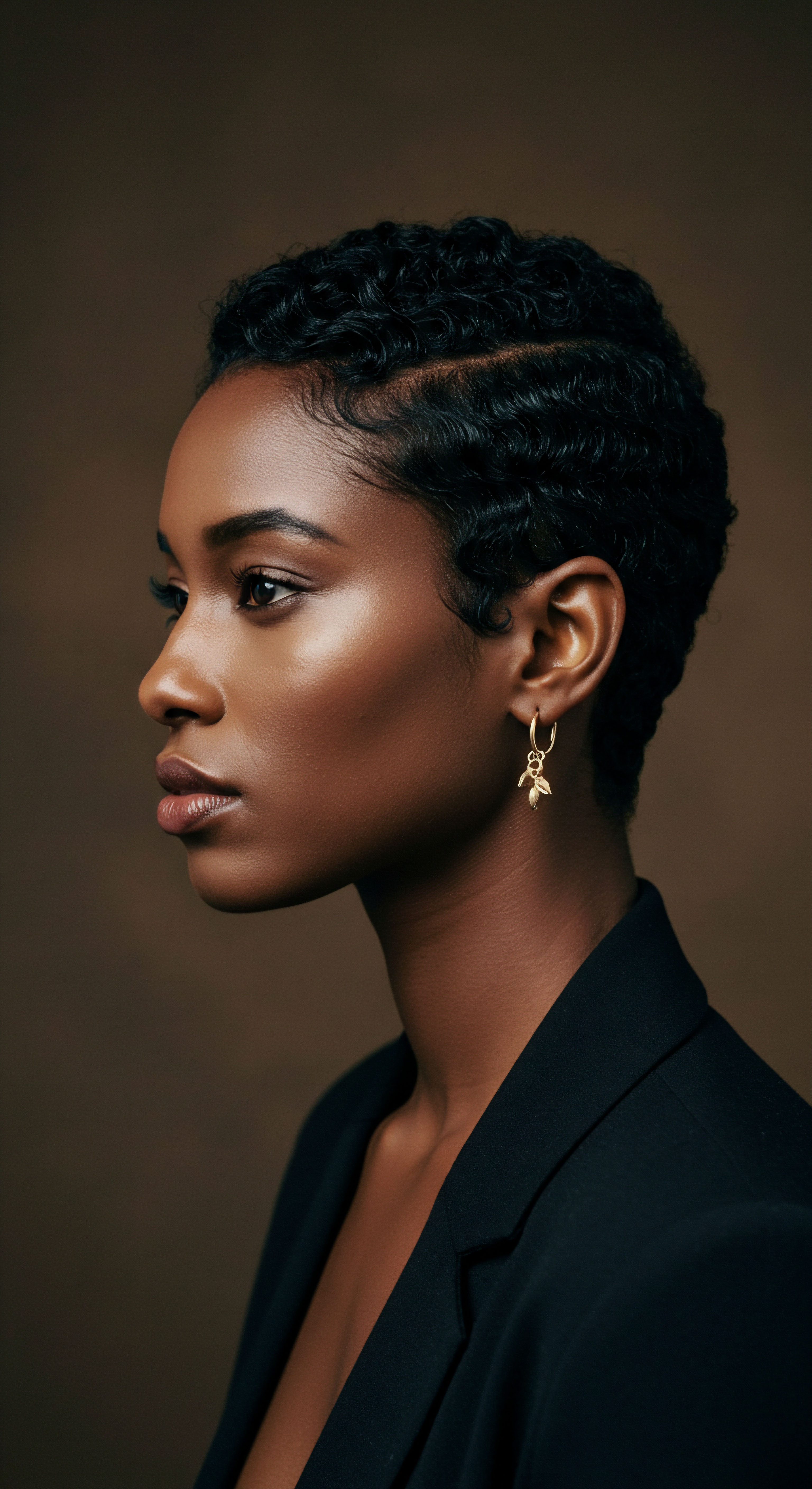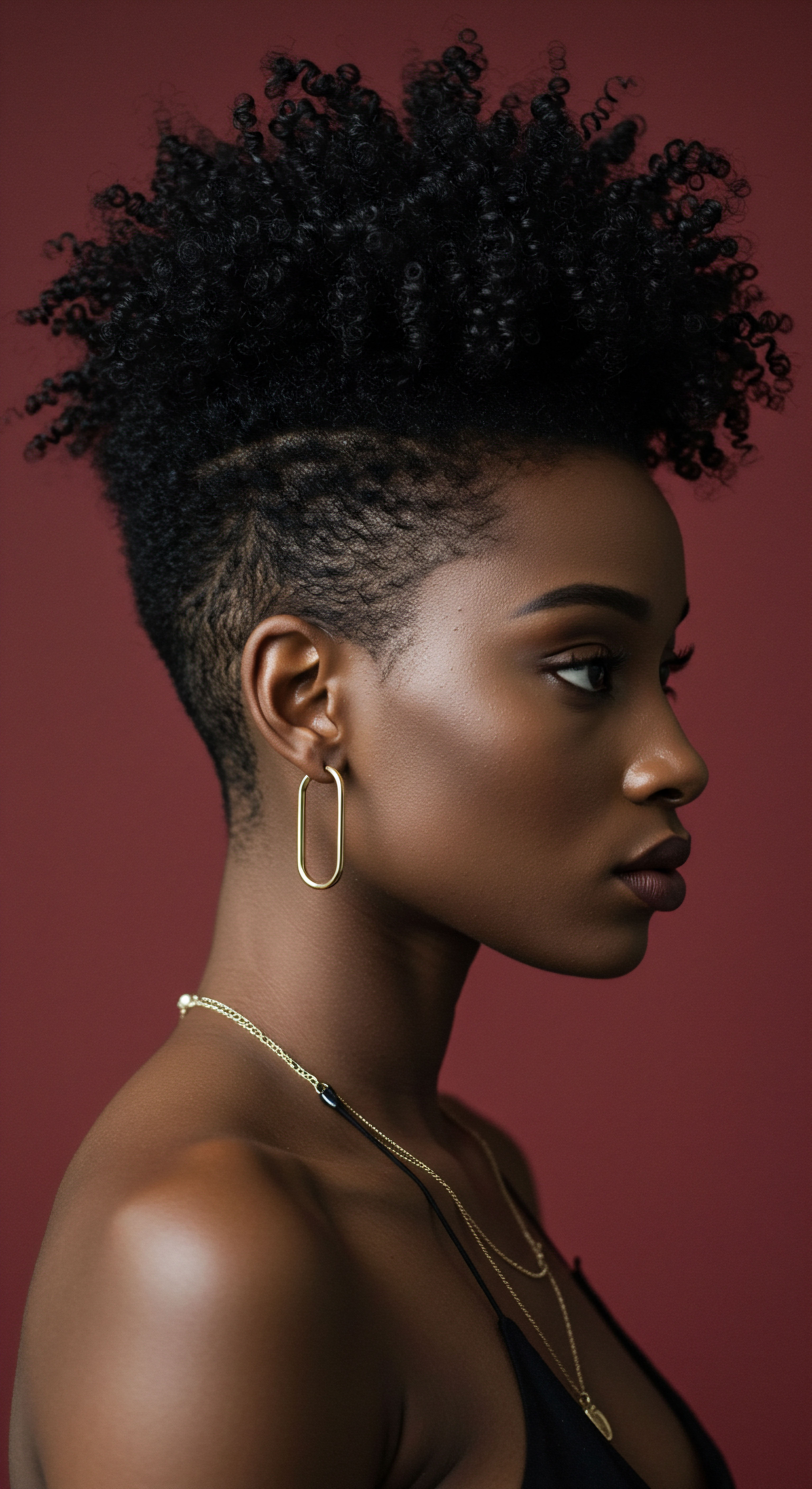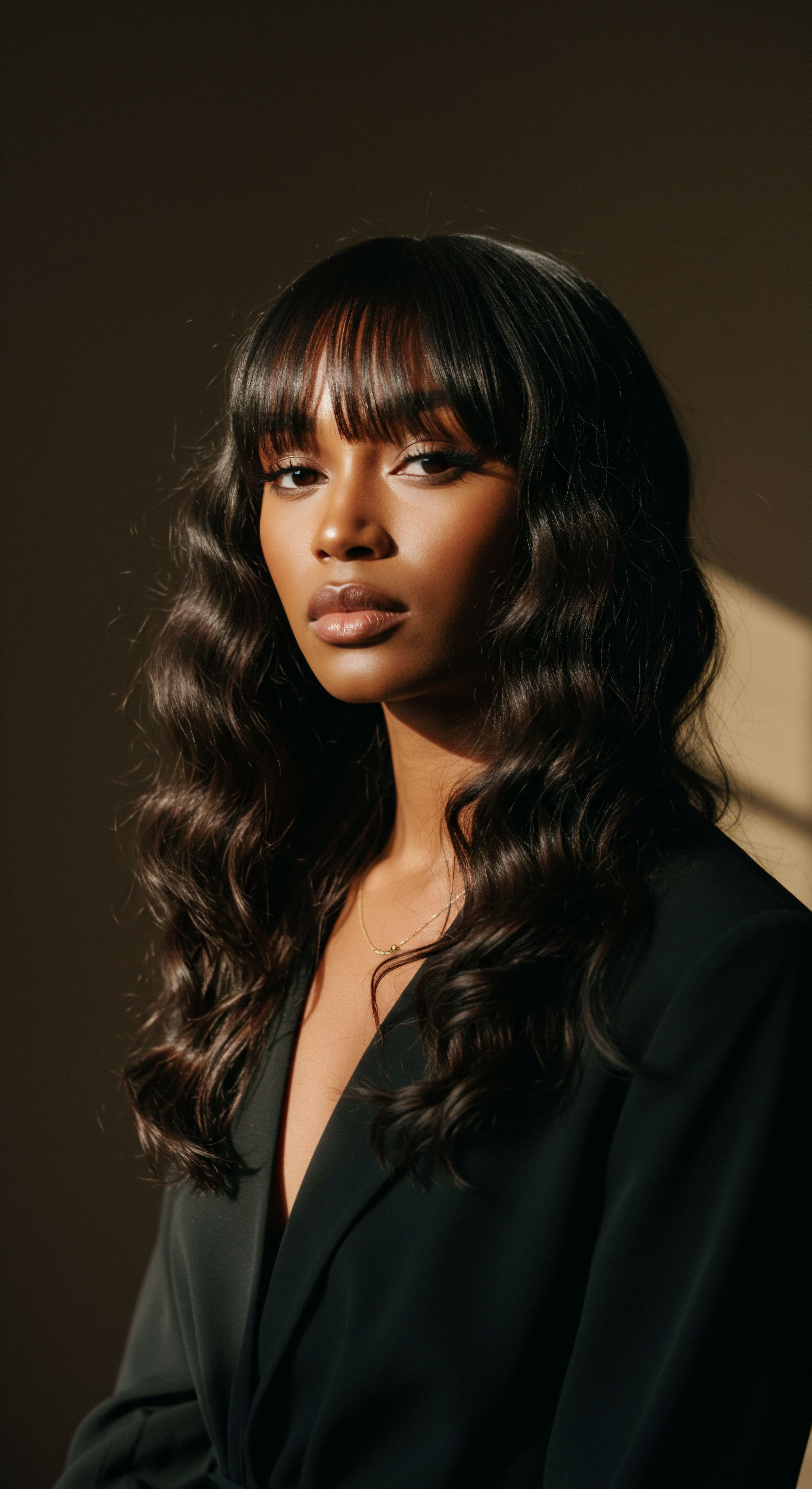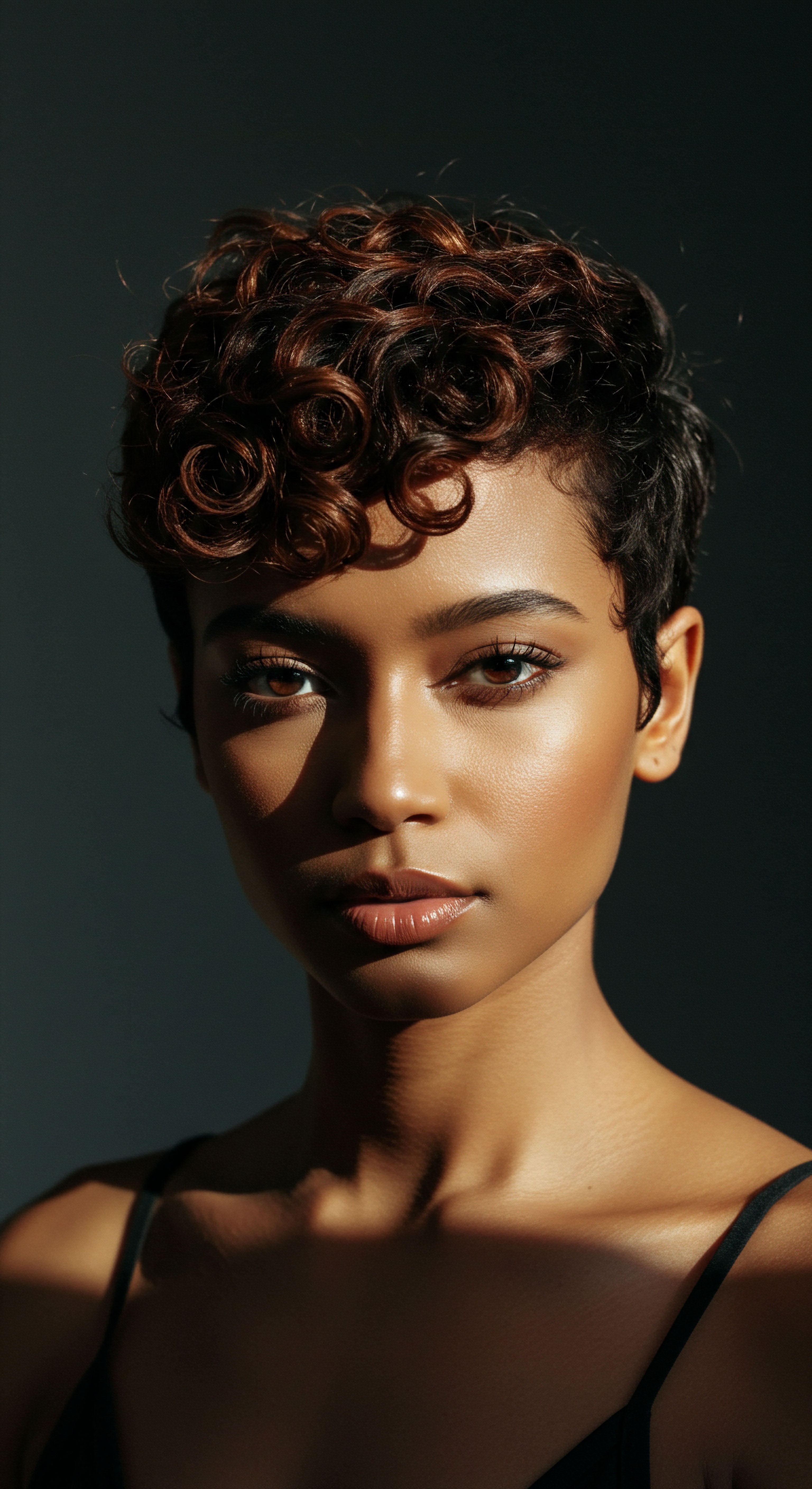
Roots
The quiet hum of water, a daily presence in our lives, often goes unexamined, its unseen composition holding secrets that ripple through our very being, even touching the delicate strands that crown us. For those with textured hair, this elemental liquid, flowing from our taps, carries more than just life-sustaining properties; it bears an invisible cargo, a collection of dissolved minerals and chemical agents that can subtly, yet significantly, alter the very appearance of our hair. This transformation, often manifesting as a puzzling discoloration, invites a deeper inquiry into the foundational interaction between water’s chemistry and the intricate structure of textured hair. We seek to understand the quiet conversations happening between your water and your strands, a dialogue that shapes not only their health but their very hue.
The journey into understanding hair discoloration begins with a close look at water itself. Municipal water systems, in their pursuit of public health and safety, treat water with various agents and draw from diverse sources, each contributing its own unique chemical signature. This signature, while ensuring potability, can introduce elements that react with the melanin and protein structures of hair, especially those with the unique porosity and curl patterns of textured strands.

Water’s Unseen Guests
Consider the journey of water from its source to your home. Along this path, it collects various dissolved solids, some naturally occurring, others introduced through treatment processes. These microscopic entities, often invisible to the eye, hold the capacity to bond with hair, altering its surface and, over time, its color. The porosity of textured hair, with its often raised cuticle, can make it particularly receptive to these deposits, allowing them to settle and accumulate more readily than on smoother hair types.

How Do Water Impurities Bond with Hair?
Hair, at its core, is a complex protein structure, primarily keratin. This protein possesses various binding sites, particularly negatively charged ones, which attract positively charged ions present in water. When water rich in certain minerals comes into contact with hair, these ions can cling to the hair shaft, forming a layer of mineral buildup.
This layer not only obscures the hair’s natural pigment but can also interfere with light reflection, leading to a dull or altered appearance. The continuous exposure, wash after wash, builds upon itself, making the discoloration more pronounced over time.
The subtle interplay between water’s dissolved minerals and the intricate protein structure of textured hair often initiates an unseen alteration in its natural hue.
The impact is not merely superficial. These mineral deposits can also lift the hair’s cuticle, making it rougher and more susceptible to further damage and color changes. This effect is particularly noticeable in textured hair, where the cuticle is already naturally more lifted at the curves of the strand.

Decoding Hair’s Chemistry and Structure
To grasp the effects of water on hair color, we must acknowledge the inner workings of the hair shaft. Melanin, the pigment responsible for hair color, resides within the cortex of the hair strand. Eumelanin provides black and brown tones, while pheomelanin provides red and yellow tones.
The cuticle, the outermost layer of the hair, serves as a protective shield. When this shield is compromised, whether by chemical processes or environmental factors, the inner cortex and its precious melanin become vulnerable.
- Hair’s Outer Layer the cuticle, serves as a protective barrier, yet its integrity is compromised by certain waterborne elements.
- The Cortex nestled beneath the cuticle, houses melanin, the pigment that determines hair’s natural color.
- Porosity the ability of hair to absorb moisture, plays a significant role in how readily minerals cling to the hair shaft.
Textured hair, by its very nature, often exhibits higher porosity due to the structural variations along its helical path. This increased porosity means that water, along with its dissolved guests, can penetrate the hair shaft more easily, leading to a more direct interaction with the melanin and keratin within. This heightened absorption makes textured hair a more receptive canvas for the chemical reactions that cause discoloration.
| Contaminant Chlorine |
| Typical Source Disinfectant in municipal water |
| Initial Hair Effect Drying, stripping of natural oils, potential for brassiness |
| Contaminant Copper |
| Typical Source Corroding pipes, natural deposits |
| Initial Hair Effect Greenish tint, especially on lighter hair; dulling on darker hair |
| Contaminant Iron |
| Typical Source Corroding pipes, natural deposits |
| Initial Hair Effect Orange, red, or brownish discoloration |
| Contaminant Calcium/Magnesium |
| Typical Source Hard water minerals |
| Initial Hair Effect Mineral buildup, dullness, reduced manageability |
| Contaminant These elements, while present in varying concentrations, contribute to the cumulative effect on hair appearance. |

Ritual
Moving from the fundamental understanding of water’s components, we now turn our attention to the daily and periodic practices that shape the lived experience of textured hair, particularly when confronted with the subtle shifts in hue caused by waterborne chemicals. The washing ritual, a cornerstone of hair care, becomes a critical point of interaction, where the water’s silent agents meet the hair’s delicate structure. This section explores how these common chemicals manifest their presence on textured strands and what gentle, considered practices can mitigate their effects.
The consistent exposure to tap water, often rich in minerals and disinfectants, creates a cumulative effect on textured hair. What begins as a slight dullness can progress to a noticeable shift in color, particularly for those with lighter natural shades or color-treated hair. The porosity of textured hair, with its often open cuticle, acts as a sponge, readily absorbing these unwelcome guests.

The Persistent Problem of Chlorine
Chlorine, a ubiquitous disinfectant in municipal water supplies, is a powerful oxidizing agent. While it ensures water safety, its interaction with hair, particularly textured hair, is a story of gradual erosion. Chlorine can strip away the hair’s natural protective oils, the very lipids that contribute to its shine and pliability. This removal leaves the hair more vulnerable, its cuticle more exposed, and its inner cortex susceptible to oxidative damage.
For textured hair, which already tends to be drier due to its curl pattern hindering oil distribution, chlorine exacerbates this dryness, making strands brittle and prone to breakage. The oxidative action of chlorine can also react with melanin, causing darker hair to appear duller or brassy, and lighter hair to develop a greenish tint.

Does Chlorine Really Change Hair Color?
While chlorine itself doesn’t directly dye hair green, its oxidizing properties react with trace metals, primarily copper, that may be present in the water or even accumulate on the hair from pipes. Chlorine facilitates the bonding of these metals to the hair protein. A study published in the Journal of Cosmetic Science examined the impact of swimming pool water on hair, noting that the combination of chlorine and copper ions was the primary culprit behind green discoloration, particularly in lighter hair.
This interaction creates a visible greenish hue as the copper ions bond with the keratin. For darker textured hair, the effect is often a loss of vibrancy, a dulling, or a subtle reddish-brown shift, as the melanin is oxidized and its rich tones are diminished.
Chlorine’s oxidative nature, coupled with trace metals like copper, can lead to visible discoloration and diminished vibrancy in textured hair.

The Mineral Veil ❉ Copper and Iron
Beyond chlorine, heavy metals like copper and iron are significant contributors to hair discoloration. These metals can leach into water from corroding pipes within older plumbing systems or be naturally present in certain water sources.
- Copper can impart a green or blue-green tint, particularly noticeable on lighter hair. On darker textured hair, it manifests as a dulling effect or a lack of luster, sometimes with an underlying brassiness that becomes visible in certain lights.
- Iron leaves behind a reddish-brown or orange stain, especially on light-colored hair. For darker textured hair, iron deposits can make the hair appear muddy, dark, or contribute to an unwanted reddish cast, particularly if the hair is already prone to warmer undertones.
- Manganese often overlooked, can cause purple or brown discoloration, particularly on blonde or chemically treated hair. For textured hair, it can contribute to an overall darkening or a murky appearance, especially when combined with other mineral deposits.
These metals, once attached to the hair shaft, are difficult to remove with standard shampoos. They act as tiny, colored particles coating the hair, obscuring its true pigment and interfering with light reflection. The buildup can also make the hair feel rough, dry, and resistant to styling.

Hard Water’s Heavy Hand ❉ Calcium and Magnesium
Hard water, characterized by high concentrations of dissolved calcium and magnesium ions, is another common culprit. While these minerals typically don’t cause direct color changes like copper or iron, their cumulative effect on textured hair is significant. Calcium and magnesium salts precipitate out of hard water and deposit themselves on the hair shaft, creating a gritty, dull film.
This mineral coating prevents moisture from truly penetrating the hair, leading to dryness and brittleness. It also makes it difficult for shampoos to lather effectively and for conditioners to provide adequate nourishment. The result is hair that feels rough, looks lifeless, and can appear lighter or duller than its true color due to the opaque mineral layer. The buildup can also make color-treated hair fade faster or appear uneven.
| Mineral Copper |
| Typical Discoloration Greenish/Blue-Green |
| Impact on Textured Hair Dulling, loss of vibrancy, subtle brassiness on darker strands |
| Mineral Iron |
| Typical Discoloration Orange/Reddish-Brown |
| Impact on Textured Hair Muddy appearance, unwanted reddish cast, darkening |
| Mineral Manganese |
| Typical Discoloration Purple/Brown |
| Impact on Textured Hair Overall darkening, murky tones, especially with other deposits |
| Mineral Calcium/Magnesium |
| Typical Discoloration Dull, Lifeless Appearance |
| Impact on Textured Hair Mineral film, dryness, brittleness, reduced shine, perceived lightening |
| Mineral The visual impact of these minerals varies based on their concentration and the hair's existing color. |

Relay
As we move deeper into the subtle complexities of textured hair care, our exploration of water’s impact takes a more sophisticated turn, inviting us to consider the intricate interplay of biological, chemical, and even socio-cultural factors that contribute to hair discoloration. This section aims to peel back the layers, moving beyond surface-level observations to a profound understanding backed by scientific inquiry and a broader contextual lens. The aim is to clarify the subtle mechanics at play, often overlooked in everyday conversations about hair health.

Oxidative Stress and Melanin Degradation
The discoloration of textured hair due to tap water chemicals extends beyond simple mineral coating. It involves a more complex process of oxidative stress and the subsequent degradation of melanin. Chlorine, a primary disinfectant, is a potent oxidizer. When it comes into contact with hair, it generates free radicals that can attack the hair’s protein structure and, significantly, its melanin pigments.
This attack disrupts the chemical bonds within melanin molecules, leading to their breakdown and a visible shift in hair color. Eumelanin, responsible for dark brown and black hair, can be particularly vulnerable, leading to a loss of depth and a reddish or brassy undertone as it degrades. Pheomelanin, which contributes to red and yellow tones, can also be affected, sometimes resulting in a washed-out or muted appearance.
This oxidative damage also weakens the hair’s structural integrity. The cuticle, which acts as the hair’s primary defense, becomes compromised, allowing more waterborne chemicals to penetrate the cortex and further accelerate pigment degradation. This creates a cycle where chemical exposure leads to structural damage, which in turn increases susceptibility to further chemical damage and discoloration.

The Less Discussed Chemicals and Their Effects
While chlorine, copper, and iron receive considerable attention, other less commonly discussed chemicals present in tap water can also contribute to textured hair discoloration. One such element is Manganese. Often found alongside iron, manganese can cause hair to take on a brown, purple, or even blackish tint, especially on lighter hair or areas of the hair that have been chemically processed. The accumulation of manganese compounds on the hair shaft can be stubborn, resisting conventional shampoos and treatments.
Another overlooked factor is the presence of Chloramines. These are compounds formed when chlorine reacts with ammonia, often used as a more stable disinfectant in municipal water systems. While less volatile than free chlorine, chloramines still possess oxidative properties that can degrade hair proteins and pigments over prolonged exposure. Their slower reaction rate means the damage can be more insidious, building up gradually without immediate dramatic effects, making their impact harder to trace.
Beyond the common culprits, less recognized elements like manganese and chloramines silently contribute to the complex chemical alterations seen in textured hair.

Water PH and Hair’s Acid Mantle
The pH of tap water also plays a critical, yet often underestimated, role in hair health and color stability. Hair and scalp maintain a slightly acidic pH, typically between 4.5 and 5.5. This acidic environment helps to keep the cuticle scales lying flat, providing a smooth, reflective surface and protecting the inner cortex. Most tap water, particularly in urban areas, tends to be neutral to alkaline (pH 7.0-8.5 or higher) due to treatment processes designed to prevent pipe corrosion.
When hair is repeatedly washed with alkaline water, the cuticle scales are forced to lift. This opening exposes the cortex to environmental damage and makes it easier for minerals and chemical agents to penetrate and deposit on the hair shaft. An open cuticle also leads to increased porosity, allowing melanin to leach out more readily, contributing to fading and discoloration. The consistent disruption of the hair’s natural pH balance can leave textured hair feeling rough, looking dull, and more prone to color changes.

Do Regional Water Differences Affect Textured Hair Color?
Indeed, the regional variations in tap water composition directly influence the type and severity of hair discoloration experienced. For instance, areas with naturally hard water, rich in calcium and magnesium, might see more mineral buildup leading to dullness and perceived lightening. Conversely, regions with older infrastructure might contend with higher levels of copper and iron leaching from pipes, leading to distinct metallic tints.
A compelling case study from a 2017 research paper, “Impact of Water Hardness on Hair Damage ❉ A Comparative Study,” highlights how hair exposed to high-hardness water experienced significantly greater protein loss and cuticle damage compared to hair washed with soft water. While not directly about discoloration, this study underscores the foundational damage that hard water causes, creating a more vulnerable canvas for discoloration-causing chemicals to act upon.
This regional variance means that a hair care regimen effective in one location might be less so in another. Understanding the local water report, often available from municipal water providers, can offer valuable insight into the specific chemical challenges faced by textured hair in a given area. This localized knowledge is crucial for developing truly effective preventative and corrective strategies.

Chelation and Clarification ❉ Counteracting Chemical Accumulation
To counteract the effects of waterborne chemicals, the principle of chelation becomes central. Chelating agents are compounds that bind to metal ions, forming stable, water-soluble complexes that can then be rinsed away from the hair. Ingredients like EDTA (ethylenediaminetetraacetic acid), phytic acid, and gluconolactone are common chelators found in clarifying or chelating shampoos. These formulations are designed to lift and remove the mineral and chemical buildup that causes discoloration and dullness.
Regular clarification, particularly for those in hard water areas or with frequent exposure to chlorinated water, is a vital step in maintaining hair health and color vibrancy. However, the strength of chelating agents means they can also be drying. For textured hair, which already leans towards dryness, balancing effective chelation with gentle, moisturizing aftercare is paramount. This often involves following a chelating wash with a deeply hydrating conditioner or mask to replenish moisture and restore the hair’s lipid barrier.
Counteracting water’s chemical influence often centers on chelation, where specific agents gently lift and remove mineral deposits from the hair shaft.
The efficacy of chelating shampoos can vary based on the specific chemicals present in the water and the extent of the buildup. Some cases of severe discoloration might require multiple treatments or stronger, professional-grade chelating services. The choice of product and frequency of use should be guided by the hair’s specific needs and the local water quality.

Reflection
Our journey through the hidden chemistry of tap water and its surprising dance with textured hair leaves us with a profound appreciation for the subtle forces shaping our strands. From the unseen minerals to the vital pH balance, each element plays a part in the story of our hair’s color and vitality. This deeper understanding does not simply reveal problems; it illuminates pathways to more informed care, inviting us to engage with our hair rituals not as rote tasks, but as acts of mindful connection to the very elements that surround us. It is a quiet reminder that true hair wellness extends beyond products, reaching into the very water that graces our crowns, prompting us to seek harmony in every drop.

References
- Kim, S. H. Park, Y. M. Lee, Y. M. & Kim, J. H. (2017). The effect of swimming pool water on hair damage ❉ A comparative study. Journal of Cosmetic Science, 68(1), 59-67.
- Erceg, I. Knezović, S. & Bilić, J. (2017). Impact of water hardness on hair damage ❉ A comparative study. International Journal of Cosmetic Science, 39(4), 415-420.
- Robbins, C. R. (2012). Chemical and Physical Behavior of Human Hair (5th ed.). Springer.
- Trueb, R. M. (2016). The art of hair care. Springer.
- Waller, R. B. & Martin, D. F. (1987). Water Chemistry. John Wiley & Sons.
- Schueller, R. & Romanowski, P. (2017). Conditioning Agents for Hair and Skin. CRC Press.
- Zviak, C. & Dawber, R. (1986). The Science of Hair Care. Marcel Dekker.